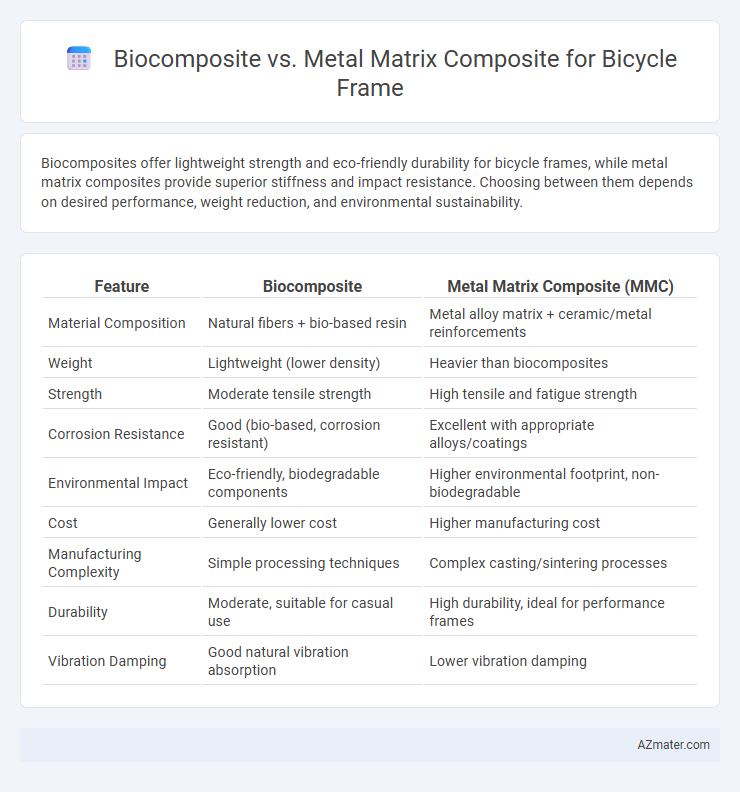Biocomposites offer lightweight strength and eco-friendly durability for bicycle frames, while metal matrix composites provide superior stiffness and impact resistance. Choosing between them depends on desired performance, weight reduction, and environmental sustainability.
Table of Comparison
| Feature | Biocomposite | Metal Matrix Composite (MMC) |
|---|---|---|
| Material Composition | Natural fibers + bio-based resin | Metal alloy matrix + ceramic/metal reinforcements |
| Weight | Lightweight (lower density) | Heavier than biocomposites |
| Strength | Moderate tensile strength | High tensile and fatigue strength |
| Corrosion Resistance | Good (bio-based, corrosion resistant) | Excellent with appropriate alloys/coatings |
| Environmental Impact | Eco-friendly, biodegradable components | Higher environmental footprint, non-biodegradable |
| Cost | Generally lower cost | Higher manufacturing cost |
| Manufacturing Complexity | Simple processing techniques | Complex casting/sintering processes |
| Durability | Moderate, suitable for casual use | High durability, ideal for performance frames |
| Vibration Damping | Good natural vibration absorption | Lower vibration damping |
Introduction to Bicycle Frame Materials
Bicycle frame materials primarily include biocomposites and metal matrix composites, each offering distinct performance characteristics. Biocomposites, made from natural fibers and biodegradable polymers, provide lightweight, eco-friendly options with good vibration damping, ideal for sustainable cycling solutions. Metal matrix composites combine metals like aluminum or magnesium with ceramic reinforcements, delivering superior strength, stiffness, and durability for high-performance and heavy-duty bicycle frames.
Understanding Biocomposites in Cycling
Biocomposites in bicycle frames combine natural fibers and biodegradable polymers, offering lightweight, sustainable alternatives to traditional materials. These composites enhance vibration damping and reduce environmental impact compared to metal matrix composites, which provide higher strength and stiffness but involve heavier weight and complex recycling challenges. Understanding the trade-offs in mechanical performance and eco-friendliness is crucial for selecting the ideal composite material for cycling applications.
Overview of Metal Matrix Composites (MMC)
Metal Matrix Composites (MMCs) for bicycle frames combine lightweight metals like aluminum or magnesium with reinforcing materials such as silicon carbide or carbon fibers, resulting in enhanced strength-to-weight ratios and improved wear resistance compared to traditional metals. MMCs offer superior stiffness, thermal stability, and fatigue resistance, making them ideal for high-performance cycling applications where durability and reduced weight are critical. These composites also provide better damping characteristics and corrosion resistance, contributing to long-lasting, reliable bicycle frames.
Mechanical Properties: Strength and Stiffness Comparison
Biocomposite bicycle frames offer high strength-to-weight ratios and enhanced vibration damping but generally exhibit lower stiffness compared to metal matrix composites (MMCs). MMCs, typically made from aluminum or titanium reinforced with ceramic particles, provide superior stiffness and fatigue resistance, making them ideal for high-performance cycling applications. The choice between biocomposites and MMCs depends on the desired balance between lightweight comfort and mechanical durability.
Weight Considerations: Biocomposite vs Metal Matrix
Biocomposite bicycle frames offer significantly lower weight compared to metal matrix composites due to their natural fiber reinforcements and lightweight resin matrices, making them ideal for riders prioritizing agility and speed. Metal matrix composites, while heavier, provide superior strength-to-weight ratios and enhanced durability, suitable for riders demanding higher performance under stress. Weight considerations lean towards biocomposites for lightweight designs, whereas metal matrix composites excel in applications requiring increased stiffness and impact resistance.
Durability and Fatigue Resistance
Biocomposite bicycle frames, made from natural fibers embedded in polymer matrices, offer excellent fatigue resistance due to their ability to dissipate energy and resist crack propagation, while providing moderate durability with resistance to corrosion and impact. Metal matrix composites (MMCs), combining metal alloys with ceramic reinforcements, exhibit superior durability through high stiffness and strength but face potential fatigue challenges from microstructural defects and thermal stresses. Considering long-term fatigue behavior, biocomposites excel in cyclic load absorption, whereas MMCs provide enhanced structural integrity under high stress conditions, making the choice dependent on riding style and environmental exposure.
Environmental Impact and Sustainability
Biocomposite bicycle frames, made from natural fibers and bio-based resins, significantly reduce carbon footprint and promote biodegradability compared to metal matrix composites, which rely on energy-intensive metal extraction and processing. Metal matrix composites offer superior mechanical strength and durability but have higher environmental costs due to mining, high-temperature manufacturing, and limited recyclability. Choosing biocomposites enhances sustainability by utilizing renewable resources and lowering emissions, aligning with eco-friendly transportation goals.
Manufacturing Processes and Scalability
Biocomposite bicycle frames are typically manufactured using processes such as compression molding, resin transfer molding, or filament winding, offering lower energy consumption and greater sustainability compared to metal matrix composites (MMCs). MMC frames require advanced techniques like powder metallurgy or stir casting, which involve higher temperature processing and precise control, limiting scalability and increasing production costs. The scalability of biocomposites benefits from faster cycle times and renewable raw materials, while MMCs face challenges in mass production due to complex equipment needs and longer processing times.
Cost Analysis: Biocomposite vs MMC Frames
Biocomposite bicycle frames offer significant cost advantages due to the lower price of natural fibers and resin matrices compared to the expensive metals and metal alloys used in Metal Matrix Composites (MMCs). Manufacturing biocomposite frames typically requires less energy and simpler processes, reducing overall production expenses relative to MMC frames that involve complex metallurgy and high-temperature fabrication techniques. While MMC frames provide superior strength-to-weight ratios, their higher raw material and processing costs make biocomposites a more economical choice for budget-conscious consumers seeking sustainable and lightweight bicycle frames.
Future Trends in Bicycle Frame Engineering
Biocomposites for bicycle frames offer sustainable, lightweight alternatives with enhanced vibration damping and environmental benefits, increasingly favored in eco-conscious design trends. Metal matrix composites (MMCs) provide superior mechanical strength, corrosion resistance, and high-temperature performance, ideal for high-performance and competitive cycling applications. Future trends in bicycle frame engineering emphasize hybrid material systems combining biocomposites with MMCs to optimize strength-to-weight ratio, durability, and sustainability in next-generation bicycles.

Infographic: Biocomposite vs Metal matrix composite for Bicycle frame
 azmater.com
azmater.com